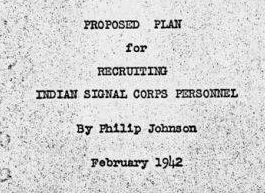Even though the Choctaw language was useful in WWI, German intelligence agencies were aware of the use of Amerindian languages and in the time between the wars, Germans studied native languages from published sources and sent students to the U.S. to study the languages. This made the U.S. military uneasy about continuing to use Native American languages for securing messages (Watkins).

"Phillip Johnston" (Navajo Interpreter)
The answer to this problem came from Phillip Johnston, a native Navajo who grew up speaking the Navajo language (NAU). Due to the Navajo language not being written, the Germans weren’t able to study the language or obtain any knowledge for it. As a native speaker, Johnston knew the complexity of the dialects, syntax, and tones was a benefit to encryption (Watkins). Additionally, the Navajo language doesn’t have a written alphabet or symbols and is only spoken by the people on the Navajo Indian Reservation (Infoplease). When new concepts developed, the Navajo added new words instead of incorporating words from other languages. These new Navajo words were easily recognizable by those who knew the language, but impossible to recognize for those who did not (Watkins). The unique features of the Navajo language made it perfect for communicating messages in battles without being decrypted.


"The plans Phillip proposed" (Proposed Plan for Recruiting Indian Signal Corps Personnel, 1942)